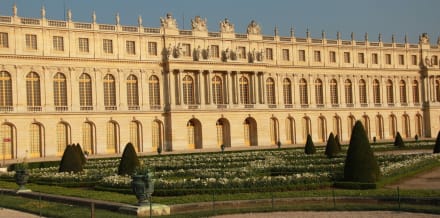More about: 11 Things to See at the Palace of Versailles
A World Heritage Site, the Palace of Versailles is one of the most important 17th century sites on the continent. What began as Louis XIII's hunting ground has become over the years one of the most important monarchical complexes in the West.
The accession to the throne of Louis XIV and the French Revolution have modified and nurtured this place, making it one of the most visited museums in France. If what you want is to feel for a day how the monarchy lived, get ready because I'll give you an overview of what you can't miss in Versailles. So, don't wait any longer and book your ticket to Versailles and the gardens.
1. Hall of Mirrors
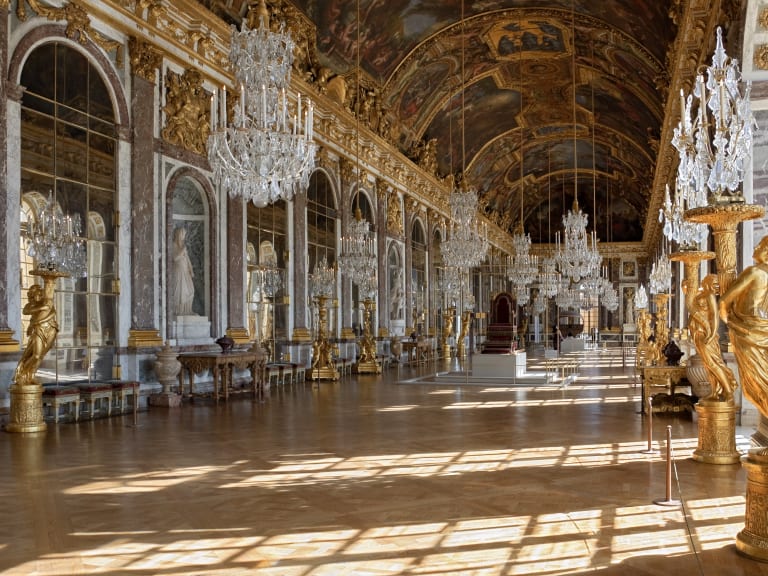
Built in 1684 and with a marked Baroque style, the Hall or Gallery of Mirrors is undoubtedly one of the rooms in the Palace of Versailles that attracts the most tourists throughout the year. What was originally commissioned by the king to impress his visitors has now become the emblematic icon of the Palace.
It may seem banal now, but at the time, the manufacture and possession of mirrors was a luxury that not many could afford. That is why Louis XIV wanted to fill the room with huge windows and mirrors throughout the room to demonstrate the power of his reign.
The room has an impressive vault painted by the artist Le Brun and has been used for centuries as a place to hold events, balls and parties, but also to sign important treaties such as the Treaty of Versailles, which put an end to the First World War. Undoubtedly, a historic place that is well worth a stop.
2. The King's and Queen's Chambers

If you want to see first-hand how the 17th century kings who changed the history of France lived, don't hesitate to take an excursion from Paris with a guided tour of Versailles and, of course, don't miss the detail of their own rooms. The King's and Queen's Chambers are two of the most important and central rooms in Versailles, as they constitute the most personal and intimate part of royal life.
Although the image of unity of the kings was just as important as it is today, both had separate rooms adapted to the needs and protocols. Thus, although both Chambers are equally decorated and luxurious, in the King's chamber the court attended his morning wake-up, lunchtime and bedtime every morning.
These two Chambers have as their centrepiece the royal apartments, where you can see the bed where Louis XIV himself slept and where he perished in 1715. A first-hand experience of the ostentation and luxury of the period is an essential part of your visit to the Palace and is easily accessible after seeing the acclaimed Hall of Mirrors.
3. The Royal Chapel

Every self-respecting palace at the time needed a chapel to match the renown of its members for daily masses and ceremonies. As you might have guessed, in the case of Louis XIV and his Palace of Versailles, the Royal Chapel ended up becoming one of the most sumptuous places in the whole complex.
From the outside you can see how it stands out from the rest of the building due to its vaulted ceilings, but what will undoubtedly leave you speechless is its interior. With an impressive solid marble floor and all the walls and ceiling painted by artists of the time, the Chapel Royal cost over two million pounds at the time.
The Chapel the Sun King never got to enjoy
The paradox of this Chapel Royal is that Louis XIV put a lot of effort and money into its construction. However, the result that you will be able to enjoy on your visit was not finished until 1710, and it was only five years later when the monarch died, bringing to an end the era of absolute monarchy in France.
4. The Battle Gallery
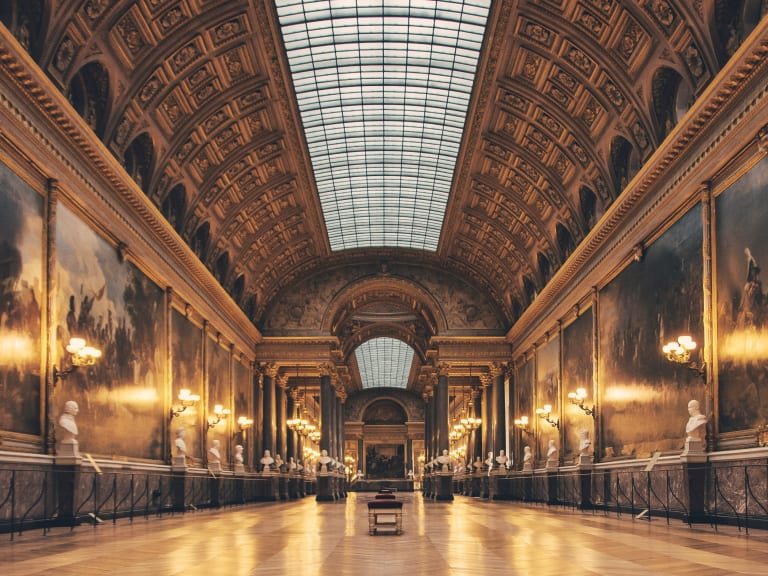
Before photography and social media, memories were stored in pictures and, as Versailles liked to do everything on a grand scale, King Louis-Philippe had the idea in 1837 to build a huge gallery in the Palace to portray the country's great battles and achievements. This gallery, which you can access with your ticket to Versailles, occupies practically the entire floor of the south wing of the palace and has become one of the obligatory stops.
As if it were a pantheon of old glories, the reign of Louis Philippe was responsible for creating and collecting as many busts as paintings that tell how the Kingdom of France was forged, from battles as old as that of Tolbiac, to some from his own century such as that of Wagram.
This gallery has practically become a museum within a museum and tends to attract the attention of visitors with its enormous proportions and magnificent historical classification, serving almost as a script for understanding the entire history of the period. Some of the great paintings on display here that you can't miss are:
- *The Battle of Austerlitz by François Gérard.
- *The Entry of Henry IV into Paris by François Gérard.
- *TheBattle of Fontenoy by Horace Vernet.
- *The Battle of Bouvines by Horace Vernet.
5. The Salons of the Empire
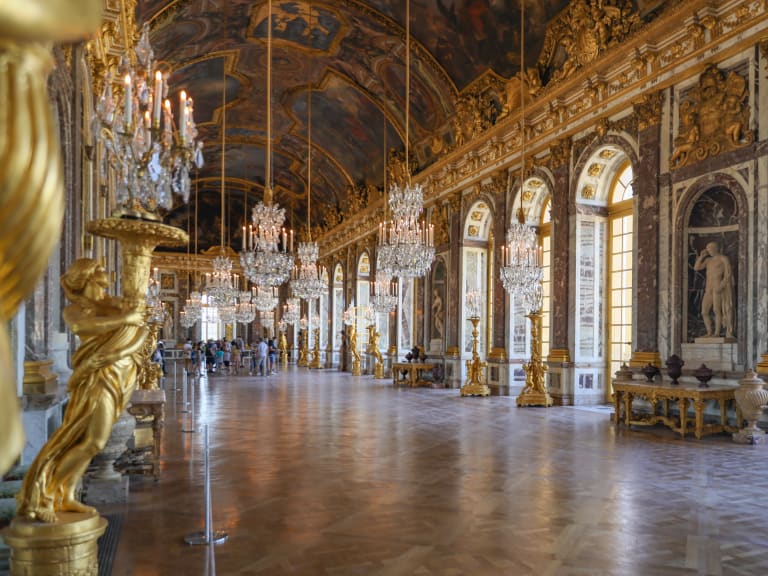
In these three rooms, you will have the opportunity to see the remains of a great project undertaken by Louis-Philippe to reflect the great glories of France. His reign was very important for the Palace and you will quickly realise on arrival that two main periods can be distinguished; that of the Royal Residence of the absolutist monarchies and that of the Museum of History.
Much of the splendour of the Palace of Versailles took place during the 17th century and the reign of Louis XIV. However, after the French Revolution, it was abandoned and it was the arrival of Louis-Philippe, in the 19th century, who was responsible for giving the complex a new look. The king wanted to give the palace back its essence and royal distinction, and this period is clearly reflected in the Salons de l'Empire which, consisting of three rooms, form part of what was known at the time as the Museum of the History of France.
The Salons de l'Empire are not open to the public in their entirety, but you will always have the opportunity to see part of these large rooms where you can see the works that the king himself had painted to reflect the entire period of France, including the Directory, the Consulate and the Empire.
6. The apartments of Louis XV's daughters.

One of the most popular stories among visitors is that of the three daughters of Louis XV, or as they have been known for centuries, the Mesdames. The sisters lived their entire lives in the palace during their father's reign and remained unmarried all their lives, attracting the attention of the court and making them known as the "King's spinsters".
During your visit to the Palace of Versailles, you can find out which were the rooms where these three sisters lived practically all their lives, passing from king to king, until the arrival of the French Revolution, when they were forced to flee the palace.
7. The Hall of the Crusades

The Palace of Versailles is full of completely unexpected places and one of them is undoubtedly the Crusades Room. If you like the Middle Ages, you will certainly enjoy this place like a child. Made up of five smaller rooms, this space was commissioned by King Louis-Philippe in 1843 and was intended to pay tribute to the Crusades.
The interest in the Middle Ages at the time was continued throughout the French Revolution and much of this collection of gadgets and weapons can be seen in this room, which has a vast collection of armour and shields of the main characters who took part in these battles.
8. The Gardens of Versailles
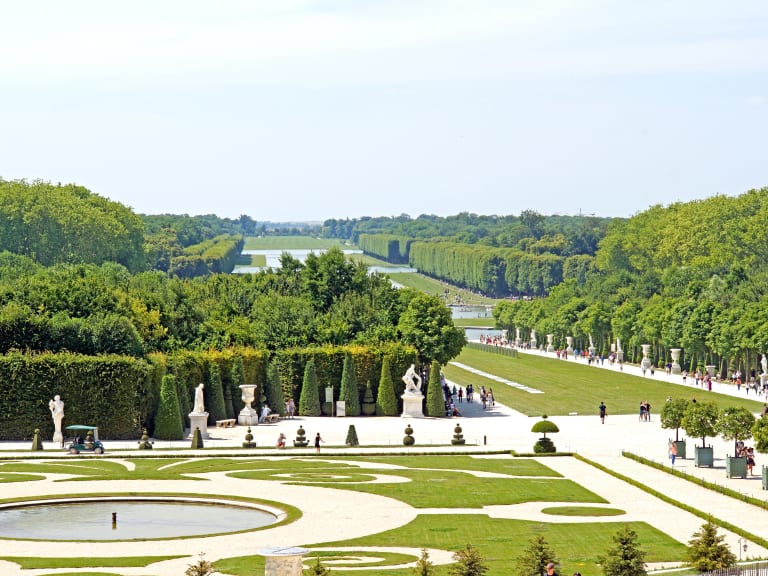
The interior of the Palace of Versailles is a real architectural and heritage spectacle. However, what really attracts and conquers most tourists is the immense garden. That's why I recommend that you buy your ticket to Versailles with the gardens. With more than 800 hectares, this vast place is full of important fountains, caves and ponds and has a very rich flora.
Touring it in its entirety is unthinkable if you are only going to spend a few hours visiting; however, you have the possibility of renting a bicycle for less than 40 euros per hour in order to get around more quickly.
The Gardens of Versailles are one of the most obvious proofs of the wealth and power of the monarchy at the time. Just passing through its maze of shrubs and trees will make you feel as small as an ant.
The fountains of the Gardens of Versailles
It would be unthinkable to cover the whole territory of the gardens, but if you want to skip a visit inside the Palace and pay attention to these enormous gardens, there are some fountains that you should not forget to see during your visit, for example:
- Latona Pond
- Pond of Apollo
- Pond of the Mirror
- Pond of Neptune
9. The Grand Trianon

The Grand Trianon is a must on your visit to the Palace of Versailles. Although it is a little way from the Gardens and the Palace, it is well worth a few minutes walk to see what was the resting place of the King of France during the 17th century.
Trianon was originally a villa close to the Palace of Versailles, but Louis XIV soon saw the opportunity to build a place where he could rest from court duties and had a huge marble building constructed which, although impressive in its own right, is much less ostentatious than the Royal Palace.
To gain access to this part of the royal complex and see the interior of the Grand Trianon, you must pay an extra fee in addition to the general entrance fee to Versailles or, if you already know what you want to see, you can opt for the "passport" pass, which gives you free access.
The Petit Trianon
Just a few steps away from the King's leisure residence, you can find the so-called Petit Trianon, a place that was used for several generations as an alternative residence and recreation centre for the Queen until it came into the hands of Marie-Antoinette.
10. The Domains of Marie-Antoinette

Marie Antoinette is undoubtedly one of the most charismatic monarchs to have ever set foot in the Palace of Versailles, and today you can visit one of the buildings she had designed during her period. The Domains of Marie-Antoinette encompasses not only the last residential period that the Petit Trianon had, but also a picturesque neighbouring village.
Marie-Antoinette's idea was to recreate in a somewhat idealised way the setting of a rural environment in which she could feel "closer" to the people. Nowadays, there is a little train that can take you to this area of the Palace of Versailles so that you don't have to waste too much time on the journey.
Marie Antoinette's animals
Inside this invention of the Queen, you can visit the mill that she ordered to be built, the lake that surrounds it, the orchards and even the cowsheds, where it is said that Marie Antoinette herself milked her cows.
Today, the installations are still preserved and, without doubt, it is a quite alternative place to the rest of the Palace where you can be more in contact with nature, just as Marie Antoinette intended. If you' re travelling to Versailles with children, this will definitely be their favourite stop as the space is still preserved as a farm and you'll be able to see animals living inside, as well as ducks, swans and geese in the centuries-old lake.
Where to eat and relax at the Palace of Versailles

Visiting the Palace of Versailles is an activity that will probably take you all day, so you will need to take a break for lunch to recharge your batteries. You should know that you are not allowed to bring food inside the palace, but Versailles has several places to eat.
These places are:
- Restaurant Angelina
- Grand Café d'Orléan
- Restaurant ORE
You will also find stalls and kiosks throughout the Gardens where you can have a bite to eat while enjoying the spectacular surroundings. You'll also find shops at the entrance and exit of the Palace of Versailles where you can take home a souvenir.
The Palace of Versailles is one of the things you have to see on your trip to Paris, as well as one of the most historic places in all of France. It is worth spending a whole day visiting it and touring all the rooms and areas inside and outside the Palace. You can take advantage of the activities or temporary exhibitions depending on the time of year you go, but, without a doubt, you can't miss the 10 must-sees we have just reviewed.
